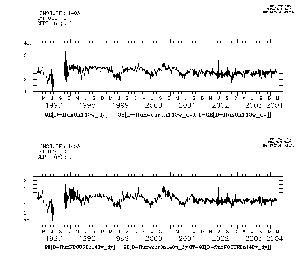|
Testing the role of surface currents in latent heat flux calculation.
Bulk latent heat flux is:
QE = rhoa Ce L S (qs - qa)
where S= sqrt(dws^2 + wg^2), and dws^2 = (u-us)^2 + (v-vs)^2 is
the relative wind speed, and wg is a gustiness factor.
In Fig. 1, Latent heat flux is computed with 3 different estimates of surface currents (us, vs):
in "fluxNOCUR", us = vs = 0 (absolute winds).
in "flux", us = mean zonal currents from Johnson et al 2002 & vs = 0.
in "fluxwcur", us, vs = daily averaged ADCP top bin at 35 m. Note, that after
the end of 2001, there is no ADCP data so I used the mean from the previous
35 m depth currents. This mean U & V is different than the Johnson et al. value.
Fig. 1. top panel: "Flux" - "Fluxwcur", i.e. QE(w/Johnson et al. mean current) - QE(w/ ADCP);
bottom panel: "FluxNOCUR" - "Fluxwcur", i.e. QE(w/o current) - QE(w/ADCP).
This figure shows that your choice of surface velocities can make upto a 40 W/m2
difference in the latent heat flux, although more typical differences
were less than 10 W/m2. The surface currents can induce a ~10 W/m2 seasonal cycle in
the latent heat flux.

|
|